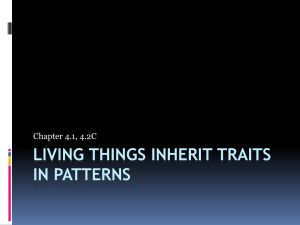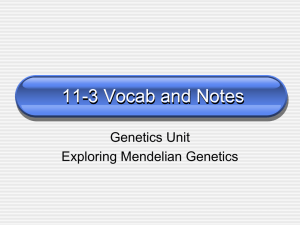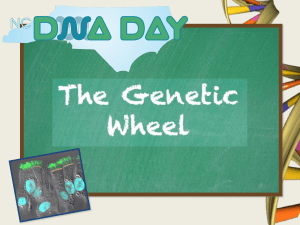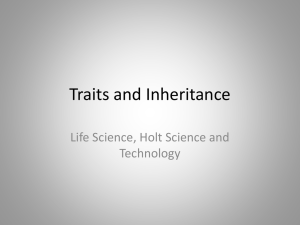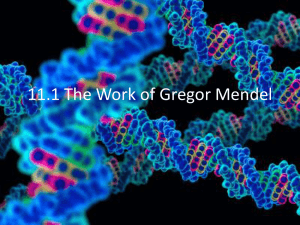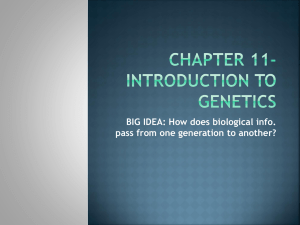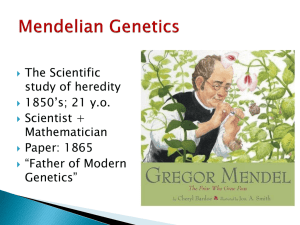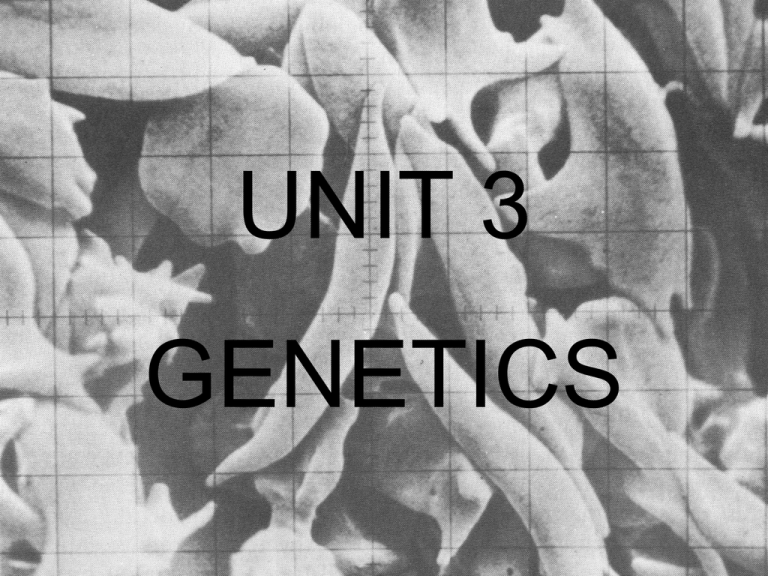
UNIT 3
GENETICS
Chapter 6
Meiosis and Mendel
“hairy ears” (hypertrichosis)- due to holandric gene.
(Y chromosome)-only occurs in males. Appears in all sons.
Polydactyly- having
extra fingers
‘Myths and Mutants’
Work with animals led to recognition of heritable
traits in humans
Stories of heritable deformities in humans appear in
myths and legends (e.g. cyclops, giants, etc.)
• 60 birth defects on
Babylonian clay tablets
(5000 years ago)
• Knowledge of traits played
role in shaping social
customs and mores (e.g.
choosing a wife/husband)
I. Chromosomes and Meiosis (6.1)
A. You have many types of specialized cells in
your body
1. Cells can be divided into two types
a. Somatic Cells- body cells. Make
up most of your body tissues and
organs.
b. Germ Cells- cells in your reproductive organs, the
ovaries and testes
1). Can develop into gametes (called sex
cells)
2). Form egg and sperm cells
2. Gametes have DNA that is passed to offspring in
chromosomes
B. Each species has characteristic number of
chromosomes per cell.
1. Chromosome number
does not seem to be
linked to complexity of
organism.
2. Organisms differ from
each other because of
way genes are
expressed, not because
they have different
genes.
II. You cells have autosomes and sex chromosomes
A. Your body has 23 pairs of chromosomes
1. Each pair referred to as homologous
pair
2. Homologous
chromosomes are two
chromosomes- one
from father and one
from mother
B. Autosomes- chromosome pairs 1-22 are called
autosomes (are homologous)
C. Sex chromosomes- pair of chromosomes
1. Directly control development of sexual
characteristics
2. Very different in humans (not homologous)
a. X chromosomefemale
b. Y-chromosomemale
Sex chromosomes
D. Body cells are diploid; gametes are haploid
1. sexual reproduction involves fusion of two
gametes
a. results in genetic mixture of both
parents
b. Fusion of egg and sperm called
fertilization
c. Egg and sperm
only have half usual
number of
chromosomes
2. Diploid and Haploid cells
a. Body cells are diploid (two copies of each
chromosome)
b. Gametes are haploid (have one copy of
each chromosome)
3. Maintaining the correct number of chromosomes is
important to survival of organisms
3. Maintaining the correct number of chromosomes is
important to survival of organisms
4. Germ cells (sex cells) undergo process of
meiosis to form gametes
a. diploid cell divides into haploid
cell
b. Sometimes called reduction
division
Haploid cells
II. Process of Meiosis (6.2)
A. Cells go through two rounds of division in
meiosis
1. Meiosis produces four haploid
cells from one diploid cell
2. Process involves two rounds of cell
division- Meiosis I and Meiosis II.
B. Homologous Chromosomes and sister Chromatids
1. Need to distinguish between the two to
understand meiosis
2. Homologous chromosomes- two separate
chromosomes- one from mother, one from
father.
a. very similar to each other- same
length and carry same genes
b. Each half of duplicated chromosome is called a
chromatid. (together called sister chromatids)
1). Homologous chromosomes divided in
meiosis I
2). Sister chromatids
not divided until
meiosis II
Sister chromotids
C. Meiosis I (first of two phases)
1. Occurs after DNA has been replicated
2. Divides homologous chromosomes in four
phases
D. Meiosis II (second of two phases)
1. Divides sister chromatids in four phases
2. DNA is not replicated between meiosis I and
meiosis II
E. Meiosis differs from mitosis in significant ways.
1. Meiosis has two cell divisions while
mitosis has one.
2. In mitosis, homologous chromosomes never
pair up
3. Meiosis results in haploid cells; mitosis
results in diploid cells.
F. Haploid cells develop into mature gametes
1. gametogenesis- production of mature
gametes
2. Differs between the sexes
a. Males produce 4 equal sperm cells
b. Females produce one large egg and smaller
polar bodies that are eventually broken down
III. Mendel and Heredity (6.3)
A. Mendel laid the groundwork for genetics
1. Traits are distinguishing
characteristics that are inherited.
2. Genetics is the study of
biological inheritance patterns
and variation.
3. Gregor Mendel showed that
traits are inherited as discrete
units.
4. Many in Mendel’s day thought
traits were blended.
B. Mendel’s data revealed patterns of inheritance
1. Mendel studied plant variation in a
monastery garden
2. Mendel made three key
decisions in his experiments
a. Control over breeding
b. Use of purebred plants
c. Observation of “eitheror” traits (only appear two
alternate forms)
3. Experimental design
a. Mendel chose pea plants because
reproduce quickly and could control how they
mate
b. Crossed purebred white-flowered with purebred
purple-flowered pea plants.
1). Called parental, or P generation
2). Resulting plants (first filial or F1
generation) all had purple flowers
c. Allowed F1 generation to self-pollinate
1). Produced F2 generation that had both
plants with purple and white flowers)
2). Trait for white had been “hidden”, it did not
disappear.
d. He began to observe patterns- Each cross yielded
similar ratios in F2 generation (3/4 had purple, and
1/4 white)
4. Mendel made three important conclusions
a. Traits are inherited as discrete units
(explained why individual traits persisted
without being blended or diluted over
successive generations)
b. Two other key conclusions collectively called the
law of segregation
1). Organisms inherit two copies of each
gene, one from each parent
2). Organisms donate only
one copy of each gene in
their gametes (two copies of
each gene segregate, or
separate, during gamete
formation
IV. Traits, Genes, and Alleles (6.4)
A. The same gene can have many versions
1. gene- a “piece” of DNA
that provides a set of
instructions to a cell to
make a certain protein.
a. Most genes exist in many forms (called alleles)
b. You have two alleles for each gene`
2. Homozygous- means two of same allele
3. Heterozygous- two different alleles
B. Genes influence the development of traits
1. Genome- is all the organisms genetic
material
2. Genotype- refers to
genetic makeup of a specific
set of genes
3. Phenotypes- physical
characteristics of organism
(wrinkled or round seeds)
C. Dominant and Recessive Alleles
1. Dominant alleles- allele that is expressed
when two different alleles or two dominant
alleles are present (use capital letter to
represent)
2. Recessive alleles- only expressed if have two
copies of recessive present (use small-case letter to
represent)
3. Homozygous dominant = TT
4. Heterozygous = Tt
5. Homozygous recessive = tt
D. Alleles and Phenotypes
1. Both homozygous dominant and
heterozygous genotypes yield a dominant
phenotype.
2. Most traits occur in a
range and do not follow
simple dominant-recessive
patterns
V. Traits and Probability (6.5)
A. Punnett squares illustrate genetic crosses
1. Used to predict possible genotypes
resulting from a cross
a. Axes of grid represent possible
gamete genotypes of each parents
b. Boxes show genotypes
of offspring
c. Can determine ratio of
genotypes in each
generation
Punnett Square
parents
gametes
Dominant Allele
Possible offspring
Recessive allele
homozygous
heterozygous
B. Monohybrid cross involves one trait
1. Homozygous dominant X Homozygous
recessive
Genotypic ratio
100% Ff
Phenotypic ratio
100% purple
2. Heterozygous X Heterozygous
Genotypic ratio
1:2:1
Phenotypic ratio
3:1
3. Heterozygous X Homozygous recessive
Genotypic ratio
1:1
Phenotypic ratio
1:1
C. Test Cross- a cross between organism with an
unknown genotype and an organism with a recessive
phenotype
D. Dihybrid cross involves two traits
1. Mendel also conducted dihybrid crosseswondered if both traits would always appear
together or if they would be expressed
independently of each other
2. Mendel discovered
phenotypic ratio in F2
generation as always
9:3:3:1 regardless of
combination traits he used
3. Mendel’s dihybrid crosses led to his second
law,the law of independent assortment.
4. The law of independent assortment states that
allele pairs separate independently of each other
during meiosis
E. Heredity patterns can be calculated with
probability
1. probability - the likelihood that a particular
event will happen
2. Probability applies to random events such as
meiosis and fertilization
VI. Meiosis and Genetic Variation (6.6)
A. Sexual reproduction creates unique gene
combinations
1. Sexual reproduction creates unique
combination of genes
a. independent assortment
of chromosomes in meiosis
b. random fertilization of
gametes
2. 223 possible sperm or egg cells produced
223 X 223 = about 70 trillion different combinations of
chromosomes
B. Crossing over during meiosis increases genetic
diversity
1. crossing over - exchange of chromosome
segments between homologous chromosomes
during Prophase I of Meiosis I
2. Results in new combination of genes
C. Linked genes - genes located on the same
chromosome inherited together.
1. Closer together they are high chance of
inheriting together
2. If genes far apart, crossing-over may
separate them
3. Gene linkage used to build genetic map of
many species
Chapter 11
Introduction to Genetics
Gregor Mendel used pea plants to study
a.
flowering.
b.
gamete formation.
c.
the inheritance of traits.
d.
cross-pollination.
Gregor Mendel used pea plants to study
a.
flowering.
b.
gamete formation.
c.
the inheritance of traits.
d.
cross-pollination.
Offspring that result from crosses between
true-breeding parents with different traits
a.
are true-breeding.
b.
make up the F2 generation.
c.
make up the parental generation.
d.
are called hybrids.
Offspring that result from crosses between
true-breeding parents with different traits
a.
are true-breeding.
b.
make up the F2 generation.
c.
make up the parental generation.
d.
are called hybrids.
What are Mendel’s factors called today?
a.
alleles
b.
traits
c.
genes
d.
characters
What are Mendel’s factors called today?
a.
alleles
b.
traits
c.
genes
d.
characters
Mendel concluded that traits are
a.
not inherited by offspring.
b.
inherited through the passing of factors
from parents to offspring.
c.
determined by dominant factors only.
d.
determined by recessive factors only.
Mendel concluded that traits are
a.
not inherited by offspring.
b.
inherited through the passing of
factors from parents to offspring.
c.
determined by dominant factors only.
d.
determined by recessive factors only.
The principle of dominance states that
a.
all alleles are dominant.
b.
all alleles are recessive.
c.
some alleles are dominant and others are
recessive.
d.
alleles are neither dominant nor recessive.
The principle of dominance states that
a.
all alleles are dominant.
b.
all alleles are recessive.
c.
some alleles are dominant and others
are recessive.
d.
alleles are neither dominant nor recessive.
When Mendel crossed true-breeding tall plants
with true-breeding short plants, all the offspring
were tall because
a.
the allele for tall plants is recessive.
b.
the allele for short plants is dominant.
c.
the allele for tall plants is dominant.
d.
they were true-breeding like their parents.
When Mendel crossed true-breeding tall plants
with true-breeding short plants, all the offspring
were tall because
a.
the allele for tall plants is recessive.
b.
the allele for short plants is dominant.
c.
the allele for tall plants is dominant.
d.
they were true-breeding like their parents.
If a pea plant has a recessive allele for green
peas, it will produce
a.
green peas if it also has a dominant allele
for yellow peas.
b.
both green peas and yellow peas if it also
has a dominant allele for yellow peas.
c.
green peas if it does not also have a
dominant allele for yellow peas.
d.
yellow peas if it does not also have a
dominant allele for green peas.
If a pea plant has a recessive allele for green
peas, it will produce
a.
green peas if it also has a dominant allele
for yellow peas.
b.
both green peas and yellow peas if it also
has a dominant allele for yellow peas.
c.
green peas if it does not also have a
dominant allele for yellow peas.
d.
yellow peas if it does not also have a
dominant allele for green peas.
When you flip a coin, what is the
probability that it will come up tails?
a.
1/2
b.
1/4
c.
1/8
d.
1
When you flip a coin, what is the
probability that it will come up tails?
a.
1/2
b.
1/4
c.
1/8
d.
1
The principles of probability can be used to
a.
predict the traits of the offspring produced
by genetic crosses.
b.
determine the actual outcomes of genetic
crosses.
c.
predict the traits of the parents used in
genetic crosses.
d.
decide which organisms are best to use in
genetic crosses.
The principles of probability can be used to
a.
predict the traits of the offspring
produced by genetic crosses.
b.
determine the actual outcomes of genetic
crosses.
c.
predict the traits of the parents used in
genetic crosses.
d.
decide which organisms are best to use in
genetic crosses.
Organisms that have two identical alleles for a
particular trait are said to be
a.
hybrid.
b.
homozygous.
c.
heterozygous.
d.
dominant.
Organisms that have two identical alleles for a
particular trait are said to be
a.
hybrid.
b.
homozygous.
c.
heterozygous.
d.
dominant.
In the Punnett square shown in Figure 11-1, which of the
following is true about the offspring resulting from the cross?
a.
About half are expected to be short.
b.
All are expected to be short.
c.
About half are expected to be tall.
d.
All are expected to be tall.
In the Punnett square shown in below, which of the following
is true about the offspring resulting from the cross?
a.
About half are expected to be short.
b.
All are expected to be short.
c.
About half are expected to be tall.
d.
All are expected to be tall.
What does a Punnett square NOT show?
a.
all possible results of a genetic cross
b.
the genotypes of the offspring
c.
the alleles in the gametes of each parent
d.
the actual results of a genetic cross
What does a Punnett square NOT show?
a. all possible results of a genetic cross
b. the genotypes of the offspring
c. the alleles in the gametes of each parent
d. the actual results of a genetic cross
If you made a Punnett square showing Mendel’s
cross between true-breeding tall plants with truebreeding short plants, the square would show
that the offspring had
a.
the genotype of one of the parents.
b.
a phenotype that was different from that of
both parents.
c.
a genotype that was different from that of
both parents.
d.
the genotype of both parents.
If you made a Punnett square showing Mendel’s
cross between true-breeding tall plants with truebreeding short plants, the square would show
that the offspring had
a.
the genotype of one of the parents.
b.
a phenotype that was different from that of
both parents.
c.
a genotype that was different from that
of both parents.
d.
the genotype of both parents.
What principle states that during gamete
formation genes for different traits separate
without influencing each other’s inheritance?
a.
principle of dominance
b.
principle of independent assortment
c.
principle of probabilities
d.
principle of segregation
What principle states that during gamete
formation genes for different traits separate
without influencing each other’s inheritance?
a.
principle of dominance
b.
principle of independent assortment
c.
principle of probabilities
d.
principle of segregation
The Punnett square in Figure above shows that the
gene for pea shape and the gene for pea color
a.
assort independently.
b.
are linked.
c.
have the same alleles.
d.
are always homozygous.
The Punnett square in Figure above shows that the
gene for pea shape and the gene for pea color
a.
assort independently.
b.
are linked.
c.
have the same alleles.
d.
are always homozygous.
How many different allele combinations would
be found in the gametes produced by a pea
plant whose genotype was RrYY?
a.
2
b.
4
c.
8
d.
16
How many different allele combinations would
be found in the gametes produced by a pea
plant whose genotype was RrYY?
a.
2
b.
4
c.
8
d.
16
Situations in which one allele for a gene is not
completely dominant over another allele for that
gene are called
a.
multiple alleles.
b.
incomplete dominance.
c.
polygenic inheritance.
d.
multiple genes.
Situations in which one allele for a gene is not
completely dominant over another allele for that
gene are called
a.
multiple alleles.
b.
incomplete dominance.
c.
polygenic inheritance.
d.
multiple genes.
A cross of a red cow with a white bull produces
all roan offspring. This type of inheritance is
known as
a.
incomplete dominance.
b.
polygenic inheritance.
c.
codominance.
d.
multiple alleles.
A cross of a red cow with a white bull produces
all roan offspring. This type of inheritance is
known as
a.
incomplete dominance.
b.
polygenic inheritance.
c.
codominance.
d.
multiple alleles.
A cross of a red cow with a white bull produces
all roan offspring. This type of inheritance is
known as
a.
incomplete dominance.
b.
polygenic inheritance.
c.
codominance.
d.
multiple alleles.
A cross of a red cow with a white bull produces
all roan offspring. This type of inheritance is
known as
a.
incomplete dominance.
b.
polygenic inheritance.
c.
codominance.
d.
multiple alleles.
Mendel’s principles of genetics apply to
a.
plants only.
b.
animals only.
c.
pea plants only.
d.
all organisms.
Mendel’s principles of genetics apply to
a.
plants only.
b.
animals only.
c.
pea plants only.
d.
all organisms.
If an organism’s diploid number is 12, its
haploid number is
a.
12.
b.
6.
c.
24.
d.
3.
If an organism’s diploid number is 12, its
haploid number is
a.
12.
b.
6.
c.
24.
d.
3.
Gametes are produced by the process of
a.
mitosis.
b.
meiosis.
c.
crossing-over.
d.
replication.
Gametes are produced by the process of
a.
mitosis.
b.
meiosis.
c.
crossing-over.
d.
replication.
What is shown in figure above?
a. independent assortment
b. b. anaphase I of meiosis
c. crossing-over
d. replication
What is shown in figure above?
a.
independent assortment
b.
anaphase I of meiosis
c.
crossing-over
d.
replication
Unlike mitosis, meiosis results in the formation of
a.
diploid cells.
b.
haploid cells.
c.
2N daughter cells.
d.
body cells.
Unlike mitosis, meiosis results in the formation of
a.
diploid cells.
b.
haploid cells.
c.
2N daughter cells.
d.
body cells.
Linked genes
a.
are never separated.
b.
assort independently.
c.
are on the same chromosome.
d.
are always recessive.
Linked genes
a.
are never separated.
b.
assort independently.
c.
are on the same chromosome.
d.
are always recessive.
If two genes are on the same chromosome and
rarely assort independently,
a.
crossing-over never occurs between the
genes.
b.
crossing-over always occurs between the
genes.
c.
the genes are probably located far apart
from each other.
d.
the genes are probably located close to
each other.
If two genes are on the same chromosome and
rarely assort independently,
a.
crossing-over never occurs between the
genes.
b.
crossing-over always occurs between the
genes.
c.
the genes are probably located far apart
from each other.
d.
the genes are probably located close to
each other.


